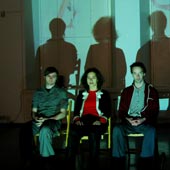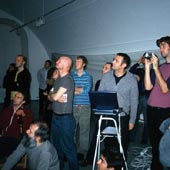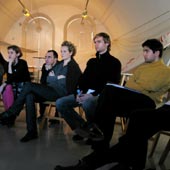architecture / public space / locative media / performance
* Presentations on the theme of architecture / public space / locative media / performance : Usman Haque (UK/Pakistan), Adam Somlai-Fischer (Hungary/Sweden), Margot Jacobs (Sweden), Andrew Paterson (UK/Finland), Ophra Wolf (UK). The purpose is to talk about how these different disciplines work together and also challenge the theme of the pixelACHE 2004 festival >> audiovisual architecture.

Usman Haque
'architecture as operating system'
Traditionally, architecture has been thought of as hardware: the static walls, roofs and floors that enclose us. An alternative approach is to think of architecture as software: the ephemeral sounds, smells, temperatures even radio waves that surround us. Pushing this analogy even further, we can think of architecture as a whole as an "operating system", within which people write their own programmes for spatial interaction. One model of operating system that is particularly relevant to architecture (since the design of space is always a collaborative process) is an open source system.
We know that architecture is political. And we know that people themselves make architecture by using it. Now, how do we balance the differences in technical skill, technology access and self-sufficiency desire that different people have, in order to produce a viably democratic space (in all senses)? Is an architecture operating system just another meta-system of control? Does open source architecture suggest a possible way forward, or is it just an empty metaphor? These are crucial questions, and I hope that a collaborative team like that assembled for RAM4 might be able to begin to look for answers.

Adam Somlai-Fischer
'Architecture as Media'
Qualities of virtual spaces are building up social conditions that architecture should respond to, the actual gets blurred with the virtual, local with the global, and our perception of space and architecture is going through major transformations. Therefore it is important to develop a more refined relation between the two realities, something beyond the visually pleasing representational VR, something that also affects back to our world.
Designing communication between different information structures includes the development of synthetic senses that take over our interpretation and create their own. A computer mouse interprets our gestures, a keyboard our language just as the technology of a camera changes the space in a photograph. This synthetic interpretation is suggestive; definitely not objective so perhaps it could even be considered creative?
Margot Jacobs
Margot is an interaction design researcher exploring the playful, emotional and appropriate incorporation of technology in everyday life, developing innovative design methods and experimental prototypes for social interventions in public space.
Public Play Spaces, a platform at PLAY Studio {Interactive Institute}:
Inside Public Play Spaces, we reflect on, question and re-examine places, relationships and qualities for the design of technology in the public sphere. This requires that we ask different questions, apply new methods and try alternative means of prototyping possibilities. Operating on the fringes, our goal is to create projects that are provocative and personal, challenging people to reflect, participate, and evolve.

Andrew Paterson
'Human Orienteering and the Remaining Traces of Locative Media'
The media environment that i feel needs a survival kit (for myself and others) is the emerging category of 'locative media'.
This label may be understood to mean media which pertains to location, but also - by inference - to a certain time, and so experienced in a certain context. Beyond the contextual signifier, it also has been associated with mobility, collaborative mapping, social networks, and relativity.
It is worth mentioning that although the initial objectives of using this term were to banish (sic.) technological jargon from media art practice and discourse, it is defining the use of spatial and mobile technolgies to augment everyday lived environments with media content.
Ophra Wolf
I have been working as a performer, both with dance and theatre companies, for many years now. But in the past two years, as artistic director of Pursue the Pulse, I have increasingly come into contact with new media and technology for art and performance. Pursue the Pulse is an international collective of artists from different fields - performance, music, video, multimedia - that specializes in the creative use of new technology. Our current project, Four Seasons, uses sensors to create an interactive environment in which a performer, the music, video, lights, and the audience all affect one another.


